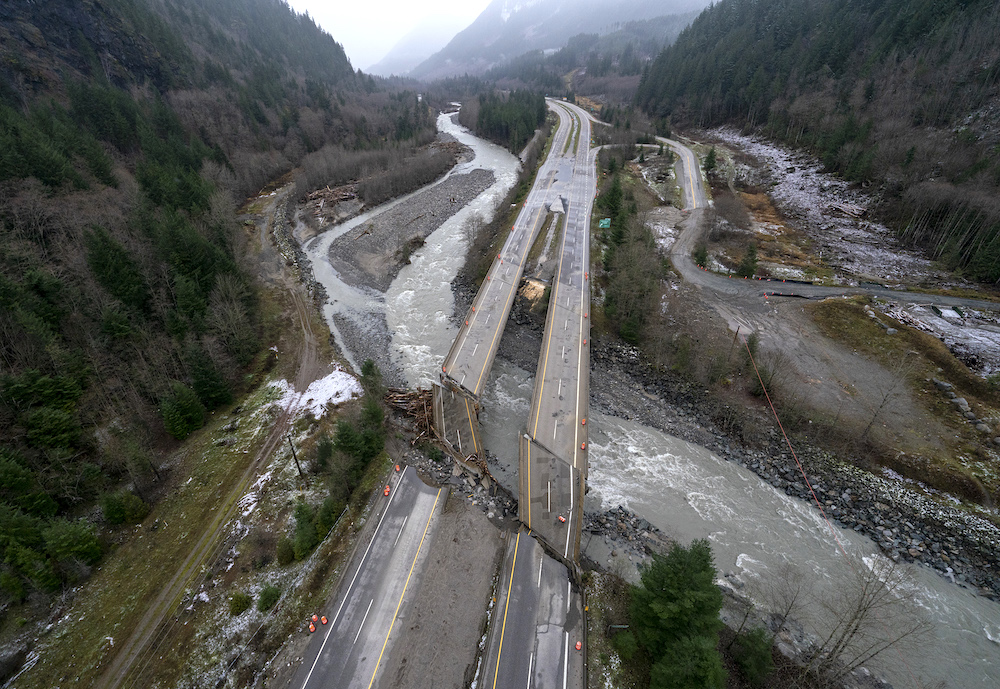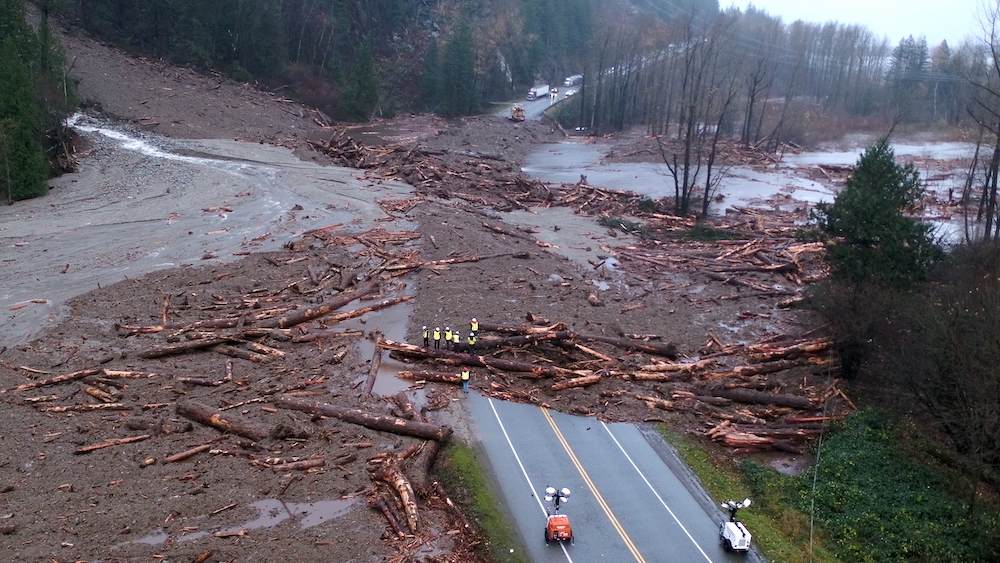
Hope cut off: B.C. community mobilizes when landslides trap commuters, cut off aid
November 8, 2022
By
Maria Church
 Damage caused by heavy rains and mudslides is pictured along the Coquihalla Highway near Hope, B.C., Thursday, Nov. 18, 2021. THE CANADIAN PRESS/Jonathan Hayward.
Damage caused by heavy rains and mudslides is pictured along the Coquihalla Highway near Hope, B.C., Thursday, Nov. 18, 2021. THE CANADIAN PRESS/Jonathan Hayward. The fire chief in Hope, B.C., as in many small municipalities across the country, wears an emergency manager hat when faced with a disaster scenario.
That scenario came to Chief Tom DeSorcy in November 2021 during the atmospheric river event that flooded B.C.’s lower mainland and crippled the flow of goods and services in the province.
As DeSorcy will tell you, the region is accustomed to “atmospheric rivers” from a weather event known as the pineapple express, when warm, moist air flows across the Pacific and pours rain on the coast. Flooding is often expected. But few were prepared for the downpour’s severity last fall.
In Hope, the deluge led to landslides that blocked or destroyed all roads and railways in and out of the community.
Hope is a transportation connector for B.C.’s lower mainland. Five highways converge in the community – From the B.C. interior, the Trans-Canada, Coquihalla Highway and Crowsnest Highway meet and then split into the Trans-Canada and Highway 7 heading to Vancouver. Both of Canada’s main rail lines, CP and CN, pass through Hope as well.
“When the storm hit, and power went out and slides started to occur and to isolate us, that was simply because of water volume. Hope didn’t flood,” DeSorcy says. Instead, the community became an island of sorts, trapping residents and travellers in and preventing outside aid from reaching them for days.
The timing of the downpour added to the situation’s severity: Nov. 14, Sunday of the Remembrance Day long weekend, when the roads were full of travellers heading home. For four nights – from Sunday to Thursday afternoon – Hope sheltered and fed around 1,200 people.
Timeline
DeSorcy recounts that there was no real warning for the intensity of the atmospheric river. He and the rest of Hope’s emergency responders were monitoring the weather event Sunday morning. “We were thinking, OK, if this is a problem, we activate our EOC. We’ll wait and see. We’ll let the river rise and the rains fall. Let’s deal with the small public works issues as we go,” DeSorcy says. “Until the slides happened.”
Power went out first. Then slide No. 1 and No. 2 on the westbound highways towards Vancouver. A neighbouring community’s fire department was responding to a small slide on Highway 1 when another slide cut off their road home and they rerouted to Hope.

Crews work to assess Highway 7 near Hope, B.C., after a mudslide closes the road at Ruby Creek. Photo:
B.C. Ministry of Transportation and Infrastructure.
Similarly, many of Hope’s regular cast of emergency operations staff commute from outside of town. “Our district hall staff that we would normally rely on, they can’t get to us. Now we’re running an emergency operations centre with two of us, myself and the town’s CAO. A third person finally joins us and we’re trying to gain some situational awareness,” DeSorcy says.
With power out and internet down at Hope’s EOC, they lost their link with Emergency Management BC (EMBC). The team packed up and moved operations to the hospital where they could plug in again and get a better sense of what was happening around Hope.
Through crowdsourcing from social media, the EOC learned about slides on the three eastbound highways out of Hope. The town was officially cut off. Knowing that shelter would be an immediate concern for those trapped in their community, EOC staff began a search for options.
The local school opened its doors first and took in nearly 750 people. A church in town took in another large group. In the days that followed, another nearby church and other private camps opened up to offer a more complete shelter option.
Managing food storage and distribution became priority No. 1. The local arena was used as a walk-in cooler for food supplies airlifted in by the province and numerous donors.
The town’s grass-runway airport saw an unprecedented amount of air traffic in and out of the community as EMBC brought supplies in and private firms arranged to take desperate travellers home.
All told, three “atmospheric rivers” hit the province that week, each one with less intensity, but each complicating the response. More than 230 millimetres of rain fell in Hope.
After four days of housing and feeding the trapped commuters, the town’s EOC got a call from EMBC. They had cleared one of the two rail lines and were arranging for a one-time, 500-person passenger train to take people from Hope to Vancouver. The line would then be used to help clear slides.
Fortunately, word came soon after that one of the westbound highways was set to reopen around the same time as the train departure.
“We were then able to give the public options,” DeSorcy says. “The road is opening, and if you need to leave direct to Vancouver, the train is coming. Seven o’clock, it’s going to go and EMBC had arranged for the Vancouver Emergency Management to have the meet-and-greet at the Vancouver terminal.”
By Thursday evening, Hope finally emptied as the stranded travellers drove or trained home.
Challenges
Social media proved to be a big challenge for Hope’s EOC. Decisions were being made about the town’s response without their knowledge, at times fuelled by commentors from outside the community.
“People were chiming in, putting out information that was not necessarily factual, but had to be responded to in some way. And do we respond to it? Do we get into a discussion with people who are not in harm’s way?” DeSorcy says.
“We’re taking in as much information as we can and we’re trying to gain situational awareness,” he says. “We tried to direct people to our site so we wouldn’t have to have discussions on every little post.”
Another challenge turned out to be a blessing. At the time of the slides, Hope was hosting the crews of the Trans Mountain pipeline expansion project. Hotels in the area that could normally handle overflow were close to capacity.
But while the shelter needs were greater, the additional peoplepower and heavy equipment was a boon for the disaster response, DeSorcy says.
“They were all in town and said, ‘Where do you want us. What can we do,’” he says. “I hazard to say that we would have been in a different situation had the pipeline project not been here. All the emergency needs in the river, all of the heavy-duty equipment would not have been here. We needed rock moved and shoring up done, diking and things. If that wasn’t here, it wasn’t getting here. And they offered it.”
Takeaways
DeSorcy has some food for thought from the entire experience.
A lesson learned is redundancy. The EOC’s internet provider went down for two weeks in their area following the slides. The centre now has two providers.
A lesson “observed” is to factor in community dynamics and relationships.
For example, Hope’s recreation facilities – the arena and pool – are both owned and operated by the regional district. Without a ticketed staff member there who is responsible for the buildings’ chemicals (ammonia and chlorine), the buildings are off limits to the public.
Other buildings are managed by groups who might be inclined to operate without direction from the EOC.
“It’s an observation we made, that you need to know who you are dealing with. Each community has its own unique situation,” DeSorcy says.
The fire chief recounts one story from the ordeal that stuck with him. After days of near constant activation, DeSorcy was en route home and swung by the rail line to check in on the passenger train as it was loading up, minutes from departure.
When he got there, he found a man in distress. He was about to board the train but had forgotten his house keys in his transport truck, parked a few kilometres away.
“I said to him, ‘I’m not permitted to take the public in my vehicle, but desperate times call for desperate measures. Get in.’ I lit the truck up, lights and sirens, took him back to the truck stop. He got his keys, and we code-3’d back to the train. I got him back just in time,” DeSorcy recalls with a laugh.
“He was so appreciative. He wrote a Facebook post thanking ‘Mr. Tom’. That was kind of fun,” he says.
Print this page